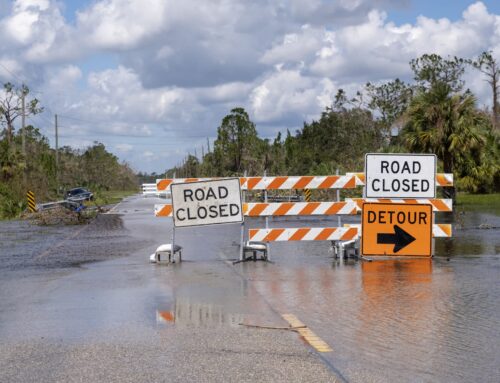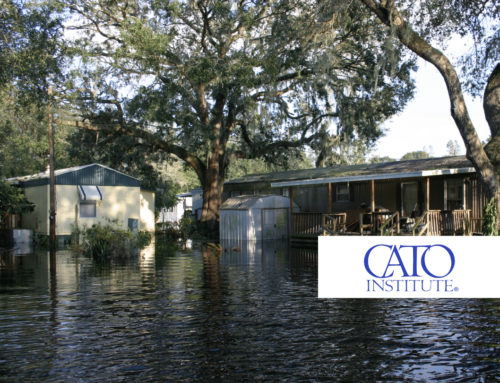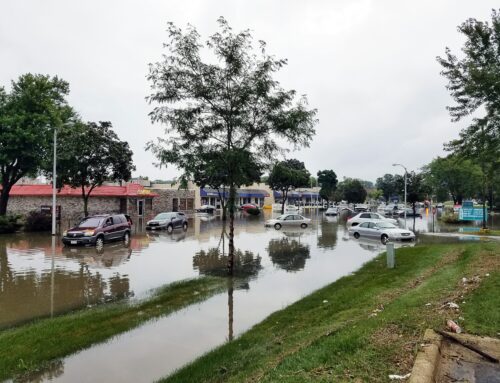Testimony of Steve Ellis
Vice President, Taxpayers for Common Sense
U.S. House of Representatives
Committee on Financial Services
hearing
“Flood Insurance Reform: A Taxpayer’s Perspective”
June 7, 2017
Good morning, Chairman Hensarling, Ranking Member Waters, members of the committee. I am Steve Ellis, Vice President of Taxpayers for Common Sense (TCS), a national non-partisan budget watchdog. Thank you for inviting me to testify on the upcoming reauthorization of the National Flood Insurance Program (NFIP) and the proposed legislative reforms. TCS has worked on flood insurance issues and reform of the program for our entire twenty-one years of existence and I’ve been involved in flood issues dating back to my days as a young Coast Guard officer dealing with the aftermath of the Great Midwest Flood of 1993. This is a critical issue for taxpayers and smart public policy that protects people and property.
Taxpayers for Common Sense is allied with SmarterSafer, a coalition in favor of promoting public safety through fiscally sound, environmentally responsible approaches to natural catastrophe policy. The groups involved represent a broad set of interests, from free market and taxpayer groups to consumer and housing advocates to environmental and insurance industry groups.[1] For a decade the coalition has advocated reforms in the National Flood Insurance Program that ensure the program is smarter and safer for those in harm’s way, the environment, and for federal taxpayers.
This brings me to the first of two issues the Committee asked me to address in my testimony: Whether the NFIP, as it is presently constituted, represents an ideal model for the effective protection of residential and commercial property owners from the damages related to flooding.
The quick and obvious answer is no–the NFIP is far from ideal. The program was created in 1968 to deal with a perceived lack of available flood insurance and to reduce ad hoc disaster payments. Nearly a half-century on, there have been enormous technological innovations that enable insurers to accurately price risk and provide products and coverages unavailable through NFIP. Instead of lack of interest from the private sector, the industry is clamoring to make reforms so that they can remove some of the risk from taxpayers like they do elsewhere in the world.
Though the NFIP provides critical insurance coverage to those at risk, the program must be significantly reformed to ensure it is financially sustainable, that there are sufficient incentives for reducing future flood damages and vulnerabilities, that it provides better protection for taxpayers who have repeatedly backstopped the program, and that it better protects the environment and promotes the use of nature-based mitigation solutions that have a long term benefit for homeowners and the taxpayers.
We applaud the committee for putting legislative pen to paper and releasing their proposals. While we would like to see some changes and improvements, the legislative drafts provide a great start to the process.
Background on the National Flood Insurance Program
It is important to understand the context of how the nation got into the flood insurance business. After years of ad hoc disaster aid being meted out by Congress, the National Flood Insurance Program (NFIP) was established in 1968 to create “a reasonable method of sharing the risk of flood losses through a program of flood insurance which can complement and encourage preventative and protective measures.”[2] The program was to make up for a perceived lack of available flood insurance. But even at that time Congress was warned that it was playing with fire. The Presidential Task Force on Federal Flood Control Policy wrote in 1966:
A flood insurance program is a tool that should be used expertly or not at all. Correctly applied it could promote wise use of flood plains. Incorrectly applied, it could exacerbate the whole problem of flood losses. For the Federal Government to subsidize low premium disaster insurance or provide insurance in which premiums are not proportionate to risk would be to invite economic waste of great magnitude.[3]
With the program nearly $25 billion in debt to taxpayers, it is clear that the program has resulted in a waste of great magnitude and not promoted a wise use of floodplains. In fact it represents a significant lost opportunity to strengthen our country’s protections against natural disasters. Although subsidies were largely envisioned to be limited and short-term, they weren’t. And while the program has encouraged standards and construction that help reduce flood risks for participating communities, the availability of subsidized federal flood insurance over the last several decades made it financially attractive to develop in high risk areas. Along with other factors, NFIP helped fuel the coastal development boom that increased the program’s risk exposure and losses.
$25 Billion in Debt and Subsidized Rates
There is a general misperception that NFIP is financially healthy but for a couple of large storms—namely Katrina and Sandy. However, for years prior to Katrina, NFIP teetered on either side of solvency, covering shortfalls with Treasury borrowing and repaying the loans in years of surplus. Then in 2005, the inevitable happened – a catastrophic loss year – and after Katrina, Rita, and Wilma, the program was roughly $18 billion in debt to the Treasury. That was followed by the Superstorm Sandy losses in 2012 which resulted in the program being $23 billion in debt to taxpayers.
Losses continue to grow, however, with 2016—as a result of Hurricane Matthew and several other rain events—representing one of NFIP’s largest loss years with $3.7 billion in payouts triggering additional borrowing from the Treasury. The program is now nearly $25 billion in debt to U.S. taxpayers. As storms and flooding become more frequent and more severe, the debt in this program will only continue to grow. Nuisance flooding, disaster declarations, and billion dollar disasters are all on the rise; leaving the flood program as is basically guarantees additional borrowing from the Treasury.
To put the program’s debt into perspective, FEMA data indicates that in 2016 the 5.1 million policies in force resulted in $3.3 billion in premiums to insure $1.25 trillion worth of property.[4] The Government Accountability Office has estimated that approximately 20 percent of policies are explicitly subsidized and paying only 35-45 percent of their actual full-risk level premiums.[5] These numbers have likely changed some subsequent to the enactment of the Homeowners Flood Insurance Affordability Act of 2014, also known as Grimm-Waters.
As this Committee well knows, reforms to the NFIP were enacted in the Biggert-Waters Flood Insurance Reform Act of 2012 to align premiums with risk, which would not only help program solvency, but also help policyholders better understand their risk and take measures to mitigate that risk. Despite some concerns, TCS supported the 2012 legislation while also favoring additional efforts to help address affordability. Unfortunately, in Grimm-Waters, Congress rolled back many of the reforms that would have led to more actuarial rates. The rollbacks actually exacerbated the inequities in the program, placing surcharges on policies to pay for continued subsidies.
The authorization for NFIP expires September 30, 2017. Before the long-term reauthorization in 2012, NFIP required 17 extensions after the 2004 reauthorization expired in 2009 and even lapsed four times only to be temporarily reauthorized retroactively. We think all involved should work together so the program doesn’t lapse again.
I would like to respond to the six legislative proposals released by the committee.
Affordability
NFIP has subsidized rates in the program virtually since its inception, regardless of need. FEMA estimates 20 percent of properties in the program pay subsidized rates, but that doesn’t include properties with grandfathered rates where the flood zone designation has changed. Even with the properties that are paying supposedly risk-based premiums, the fact that the program can borrow from the Treasury is a built-in subsidy. The GAO has documented large cross-subsidies, many of which benefit high-income homeowners.[6] They found that over 78 percent of subsidized properties in NFIP are located in counties with the highest home values (the top three deciles), while only five percent of subsidized properties are in counties with the lowest home values (the bottom five deciles)[7]. This represents a real challenge to the program’s sustainability.
TCS believes that rates in the program must over time be linked to risk while understanding that there may be some in the program who will need assistance in order to pay higher rates or reduce their risk. Currently subsidies are effectively hidden from the homeowner, which eliminates any price signal of risk or incentive to mitigate to reduce the risk and thereby the premium. Masking subsidies with lower rates prevents policyholders from understanding their true level of risk. As was noted in the FEMA privatization report mandated by Biggert-Waters, subsidized rates “can promote (and have promoted) poor decisions on the part of property owners and political representatives … they also create a moral hazard, especially when the subsidies are not well targeted.”[8] The report continues that the presences of subsidies “removes the incentive to undertake mitigation efforts, thereby encouraging ever increasing societal costs.”
To that end, we are pleased to see that the Committee’s proposal includes provisions to make premium methodology more clear to the policyholder as well as an explanation of their full flood risk and increased public access to historic loss and flood claims information to the public.
We are opposed to the artificial rate cap in the legislative proposal. As discussed rates are a clear communication of risk and provide incentives to mitigate – a far better way to reduce rates than by maintaining the risk and subsidizing the rate.
A better approach is to target any premium assistance to those who need it, and to encourage and fund mitigation measures that could serve to reduce rates by reducing risk. These mitigation efforts should be targeted at higher risk and lower income property owners.
The proposal includes a provision where states can create flood insurance affordability programs. We are pleased to see a proposal that addresses affordability and does so in a way that allows states to alter their programs based on need. We are also pleased to see that smaller states or regions could join together to create affordability plans. We do believe, however, that if a state provided affordability assistance for policyholders by merely capping rates, that wouldn’t improve the fiscal solvency of the NFIP, remove risk from taxpayers, or help foster the developing private flood insurance market. It must be clear that all policyholders must continue to be told their true risk-based rates regardless of any subsidies.
While affordability must be addressed, we must also separate out those who truly cannot afford their risk based rates and those who need time to plan for rate increases, but for whom those rates would not cause a substantial hardship. TCS is interested in developing affordability proposals further and we believe that as rates move to risk-based, Congress must ensure that there is assistance for those in need – but it must be done in a means-tested, targeted, and time-limited manner outside the rate structure. Low-income property owners should be eligible for this premium support. However, premium support is not the preferred option for reducing premiums—we should be doing more to reduce premiums by reducing risk.
While noting some of the challenges of creating a premium assistance program, an April 2017 Government Accountability Office report on flood insurance noted: “Prioritizing mitigation over premium assistance could address the policy goal of enhancing resilience because it would involve taking steps to reduce the risk of the property, thus reducing the likelihood of future flood claims and potentially reducing long-term federal fiscal exposure.”[9] To that end, TCS is supportive of the proposal’s provisions to encourage FEMA to work with policyholders without preferred risk premiums to better understand how they can reduce rates through mitigation.
We believe FEMA should be working to conduct cost-benefit analyses so that subsidies can be used for mitigation where cost-effective; this should be built into state affordability plans as well. In addition, FEMA should be required to work with private lenders as well as the Federal Housing Administration to develop or modify existing loan products that homeowners could use to mitigate thus reducing their flood insurance rates.
Private Market
Though for many years NFIP was virtually the only option for flood insurance, the private sector is writing first dollar flood insurance, even in the highest risk areas. For instance, there are at least 19 companies writing private flood insurance in Florida, home to nearly 40 percent of the NFIP policies. A majority of these are writing flood coverage in the highest risk areas, and many are providing much higher coverage limits.
This provides needed competition in the flood marketplace – it provides consumer choice in flood policies, instead of forcing homeowners to purchase a one-size fits all government policy that is significantly limited. It also takes risk off the federal government, helping to stabilize the flood program and reduce the burden on taxpayers. I request to include for the record a recent analysis done by the Reinsurance Association of America (RAA) of a comparable public insurance system for hurricane risk – Florida Citizens Property Insurance Corporation, a state-run, subsidized wind insurer. This analysis reveals the results of an effort to get the private sector to “take out” policies from the program – an exodus of nearly a million policies out of a million and a half total. But instead of choosing only low risk properties, private insurers took out properties across the risk spectrum, including those along the coast in the highest risk areas. This left a smaller and stronger state run insurance program that could meet its obligations. While it’s an extrapolation, the RAA analysis concludes that private sector engagement in flood insurance would “be extremely beneficial to both policyholders, taxpayers, and NFIP.”[10]
Through private competition, purchase of reinsurance and a continued move toward risk based rates, NFIP would be able to meet its obligation in a 100-year flood with little Treasury borrowing.
We are pleased to see that H.R. 1422, The Flood Insurance Market Parity and Modernization Act was incorporated into the legislative proposal. As you know, this common sense legislation passed the House last Congress with a 419-0 vote and represents the first step toward leveling the playing field for private sector flood insurance and bringing competition and consumer choice to the flood insurance marketplace. Private sector participation would increase coverage while decreasing the cost for consumers, and should be encouraged. Consumers should be able to choose private flood insurance policies, potentially with terms and coverage that can be tailored to the interests of the consumer, as well as better incentives for mitigation. In fact, private flood policies could allow property owners to purchase enough coverage to ensure they can rebuild after a storm, not constrained by NFIP limits or by the amount of the mortgage.
H.R. 1422 would ensure that private flood insurance counts for purposes of the mandatory purchase requirements, and would also provide an important consumer protection that ensures rate stability for consumers if they leave NFIP for private coverage and then come back to NFIP. This bill is merely a clarification that Congress never intended for homeowners to be required to purchase flood coverage through the federal government, only that they had to have coverage if they were in the 100-year floodplain and had a federally-backed mortgage. The broad, bipartisan support for the proposal is a strong statement that consumers should be given choices in flood coverage and the unanticipated regulatory hurdle to acceptance of private flood coverage should be addressed. We would also encourage a provision stipulating until regulations are in place, that lenders shall accept private coverage as long as it covers the required amount and the insurer is subject to the authority of the state insurance commissioner.
In addition we support the legislative proposal’s repeal of the non-compete provisions for Write-Your-Own (WYO) companies.
I would remiss if I did not highlight our concerns with proposals currently in the Senate that would prevent millions of homeowners currently in Special Flood Hazard Areas from opting for private flood insurance. To deny them access to the coverage that could be cheaper or better than what NFIP provides seems illogical at best. There is currently no requirement to purchase a National Flood Insurance Program policy if you are in the floodplain, only that you purchase flood insurance. This proposal turns that concept on its head.
TCS believes that the mapping fee on NFIP and private policies in the legislative proposal should be transparent to policyholders as to its provenance and use.
Finally, it is important to note that private companies will not only compete for the 5 million NFIP polices, but write coverage beyond as well. The goal is to ensure that more people around the nation purchase needed flood coverage. Recent flooding events have sadly demonstrated that many people who need coverage do not have it. The average NFIP payment for the 2016 flooding in Louisiana was $86,500, the average individual aid payment was $9,150. Absent flood insurance the homeowner is left with low interest Small Business Administration loans to rebuild. Piling a loan on top of a mortgage to rebuild a currently uninhabitable house is not conducive to efficient and resilient rebuilding. Leveling the playing field for private insurers will allow for additional property owners to benefit from insurance coverage.
Risk Analysis and Mapping
FEMA is required to map the Special Flood Hazard Area (SFHA). This delineates the area considered to have a one percent chance of flooding in any given year (so-called 100-year floodplain) and therefore has a mandatory purchase requirement for federally backed mortgages. These maps are the backbone of the NFIP and are used to determine rates. However, the flood maps do not look at property level risk or elevation, and this means there is a lack of confidence in maps and the risk analysis provided by those maps. The current lack of confidence in the flood maps hobbles FEMA implementation of the program.
Mapping is both a challenge and an opportunity. Technology has enabled greater levels of detail and accuracy in mapping. It also can be used by the private sector for more intensive risk analysis and modeling that can benefit private sector flood insurance alternatives (and NFIP as well) particularly in providing risk-based coverage in areas outside the SFHA. In addition, flood claims should inform mapping. While it is true that just because a property has never flooded in no way guarantees it won’t flood, the converse does provide an indicator. Absent significant mitigation action for structural changes, a property that has flooded is certainly at risk of flooding again. Yet, in a three-part series published in early 2014, NBC News documented instances where FEMA agreed to remap out of the floodplain large condominiums built in previously flooded areas.[11] One company head that made the remapping program his business (only for commercial properties, not residential) dubbed himself Robin Hood. Hardly. Maps have to be accurate for both sides. Taxpayers and ratepayers.
That’s why we support the legislative proposal for greater public involvement, use of risk assessment tools in determining rates and directing FEMA to work with the Technical Mapping Advisory Council to improve the mapping process.
The community mapping initiative proposal has merit and would enable communities to move the mapping process along. However, this will only work if there are sufficient standards and safeguards to ensure the maps are accurate.
I would also like the Committee proposal to go further. Mapping has to be smarter. Private companies are using tools that enable property level mapping and elevation. FEMA should be required to move to a system of more granular, property level mapping. This would not only ensure proper risk analysis and rates, but it would take the onus off homeowners who now have to go through a burdensome and expensive process if they believe they are mapped incorrectly.
FEMA should be required to assess elevation at a higher resolution or conduct more granular risk analysis. This is something that is possible—the state of North Carolina has undertaken a mapping effort where they have not only gotten property level data at a reasonable cost, but they have a digital system to allow property owners to search and understand their risk, potential flood premiums and mitigation options. FEMA should be required to move in this direction.
There are also many different federal agencies that engage in mapping. This should be more coordinated and shared among agencies to avoid duplication. This is also where – and I know this is also outside the committee’s jurisdiction – the nation’s mitigation and pre-disaster programs have to dovetail with NFIP and post-disaster response.
More needs to be done for the public to have a greater understanding of their flood risk. As discussed earlier, FEMA is tasked with mapping the SFHA for the mandatory purchase requirement. That is a federal mandate unlikely to change. However these maps are static – lines on a map designating various flood risk areas and charging various rates based on those risks. If a homeowner has an elevation certificate that proves they are elevated “out” of the floodplain they can have those rates adjusted. But the creation of the rates are sort of a black box and it’s not entirely clear that even “full-risk” rates are actuarially sound.[12] In some cases there are significant cross-subsidies where lower risk properties pay more to maintain subsidies for higher risk properties.
Mitigation
Subsidized rates provide a disincentive to mitigation, but as rates gradually increase there is more incentive for individuals, and by extension communities, to mitigate. This should be encouraged by further federal investment. While we appreciate that the committee’s proposals focus on mitigation, we believe Congress should go further to encourage mitigation before flooding occurs. We know each dollar of mitigation reduces post-disaster costs by four dollars or more.[13] Instead of going to premiums, FEMA’s subsidies should be used for mitigation where possible and cost-effective. Mitigation funds should be better targeted to homeowners and communities most at risk. We appreciate the increased level of available Cost of Compliance coverage. Regarding the Community Rating System changes, we want to be sure it isn’t just increasing credits without actually increasing a community’s use of nature-based mitigation approaches.
There is a greater benefit from larger scale, community wide mitigation efforts than mitigating house by house or property by property. In addition, this type of mitigation often becomes a community amenity that can actually increase home values beyond the flood damage reduction benefits alone. So we appreciate the inclusion of H.R. 1558, the Repeatedly Flooded Communities Preparation Act, targeting communities with large numbers of repetitive loss structures. FEMA should establish a system to promote mitigation of groups of adjacent properties in order to maximize flood damage reduction and provide additional opportunities for preservation of wetlands and other natural buffers against storm surge and other flooding.
Taxpayer Protections
TCS is pleased to see the Committee included provisions to require an annual independent actuarial review of the NFIP as well as provisions from H.R. 2246, the Taxpayer Exposure Mitigation Act that require FEMA to increase use of risk transfer tools.
I am intrigued by the Committee’s creation of the “multiple-loss property” designation and sub-categories of “repetitive-loss”, “severe-repetitive loss”, and “extreme repetitive-loss.” In general, the greater information requirements as well as the gradual removal of subsidies and shift toward risk-based rates for these properties makes sense. I would like to see what the impacts are of the interaction between current law requiring severe repetitive-loss properties movement toward risk-based rates and this proposal. In addition, targeting mitigation assistance to multiple-loss properties makes sense, but I would encourage the Committee to make it means tested. If a homeowner can afford to mitigate, they should not be subsidized to do so.
TCS also supports provisions that prospectively restrict access to NFIP for properties with extreme loss profiles. In addition, TCS supports the proposal’s concept to not make available federal flood insurance to high risk properties that are added to the SFHA as well as high value properties (greater than $1 million in value not including the value of the underlying real estate) when private coverage is available and relatively affordable. We would like to work with the Committee to make this provision simpler to administer.
We also support increased lender penalties for not enforcing mandatory purchase requirement and increased reporting requirements on compliance.
Administrative Reforms
In general, TCS supports the penalties and administrative reforms that are being adopted in the wake of policyholder experience and adjuster fraud after Superstorm Sandy.
Additional Thoughts
Adverse selection – The simple fact is that most of the people who are purchasing flood insurance are those most likely to get a payout. As I indicated there are 5.1 million policies in the program. According to the U.S. Census Bureau there are 134 million housing units[14] in the country and even leaving out multi-unit structures – that could be purchasing flood insurance – and commercial properties, roughly 5.4 percent of the houses in the country have flood insurance. Just about everybody has some level of flood risk, but for the most part, unless it’s acute, they don’t buy insurance. This means that NFIP as currently structured is essentially a high risk pool covering the most at-risk properties; the $25 billion in debt shows this to be the case. This concentration of risk has put significant strain on the program, particularly given the lack of risk-based rates. The private sector would most likely not concentrate all of their risk in flood, but would have diverse risk pools; in addition they could write multi-peril insurance that includes flood and other risks, making the pricing for the peril less, and they can also lay off risk on the worldwide reinsurance marketplace.
Reinsurance – FEMA’s recent purchase of reinsurance demonstrated there is interest and capacity in the reinsurance markets to take on U.S. flood risk. Obviously industry will have to gain a greater understanding of the nature of the underlying flood risk in the NFIP portfolio, but that can be managed through responsible data sharing. Laying off risk on the private sector will help protect taxpayers from debts racked up by future large storms.
Disaster Assistance – NFIP’s inter-relationship with federal disaster aid programs under the Stafford Act is both an opportunity for reform and a challenge to a more rational holistic federal approach.
An observation from a the 2014 FEMA privatization report “… highly publicized instances of federal aid following catastrophic events have also created a public perception that individual property owners do not need to insure against low-probability high severity flood events, effectively creating moral hazard.”[15] What people are not realizing is that the vast majority of the aid goes to rebuild public and federal infrastructure, not individuals to help them move on after disaster. A 2014 study by the Wharton Center for Risk Management and Decision Processes at the University of Pennsylvania found that increasing disaster assistance by $1,000 reduced subsequent insurance coverage by $6,000.[16]
Conclusion
Again, TCS congratulates the Committee on providing a responsible, thoughtful legislative start to NFIP reauthorization. While I noted some differences, we are ready to work with the committee to make reforms to the NFIP to ensure the program is sustainable in the long term. Coming full circle, the second topic the committee asked me to address in its invitation to testify was: “The cause of NFIP’s approximately $1.4 billion annual premium shortfall and what reforms may be needed to ensure the program collects revenue sufficient to pay expected claims.” My testimony sought to address that topic throughout. In short, with better, property level mapping, a focus on mitigation and risk reduction, a move to risk based rates with targeted subsidies, and private sector competition, we believe NFIP will be strengthened and more people will purchase needed flood coverage.
[1] Full list of groups is available at www.smartersafer.org
[2] P.L. 90-448.
[3] U.S. Task Force on Federal Flood Control Policy. “A Unified National Program for Managing Flood Losses.” August 1966. P 17. http://www.loc.gov/law/find/hearings/floods/floods89-465.pdf
[4] Federal Emergency Management Agency. Available at: https://www.fema.gov/statistics-calendar-year
[5] Government Accountability Office. “Flood Insurance: More Information Needed on Subsidized Policies.” July 2013.
[6] Supra note 5.
[7] U.S. Government Accountability Office. July 2013. Flood Insurance: More Information Needed on Subsidized Properties. (Publication No. GAO-13-607). Retrieved from: http://www.gao.gov/assets/660/655734.pdf
[8] Oliver Wyman. Flood Insurance Risk Study: “Options for Privatizing the NFIP. P60 Available at: http://www.floods.org/ace-files/documentlibrary/2012_NFIP_Reform/Reinsuring_NFIP_Insurance_Risk_and_Options_for_Privatizing_the_NFIP_Report.pdf
[9] Government Accountability Office. “Flood Insurance: Comprehensive Reform Could Improve Solvency and Enhance Resiliency.” April 2017.
[10] Reinsurance Association of America. “Private Flood Improves NFIP’s Stability.”
[11] Dedman. “Why Taxpayers Will Bail Out the Rich When the Next Storm Hits US” http://www.nbcnews.com/news/investigations/why-taxpayers-will-bail-out-rich-when-next-storm-hits-n25901 NBC News.
[12] Beider. “Understanding FEMA’s Rate-Setting Methods for the National Flood Insurance Program.” Congressional Budget Office. October 7, 2014. Available at: https://www.cbo.gov/sites/default/files/presentation/49441-femaratemethodsnfip.pdf
[13] Multi-Hazard Mitigation Council. Natural Hazard Mitigation Saves: An Independent Study to Assess the Future Savings from Mitigation Activities. Available at: https://c.ymcdn.com/sites/www.nibs.org/resource/resmgr/MMC/hms_vol1.pdf
[15] Oliver Wyman. Flood Insurance Risk Study: “Options for Privatizing the NFIP. P52 Available at: http://www.floods.org/ace-files/documentlibrary/2012_NFIP_Reform/Reinsuring_NFIP_Insurance_Risk_and_Options_for_Privatizing_the_NFIP_Report.pdf
[16] Kousky, Michel-Kerjan, Raschky. Does Federal Disaster Assistance Crowd Out Private Demand for Insurance? Available at: http://opim.wharton.upenn.edu/risk/library/WP2013-10_FedDisasterAssistance.pdf











Get Social